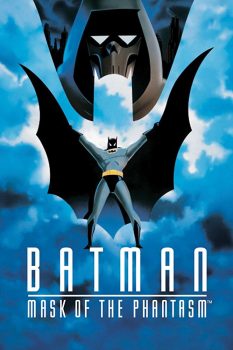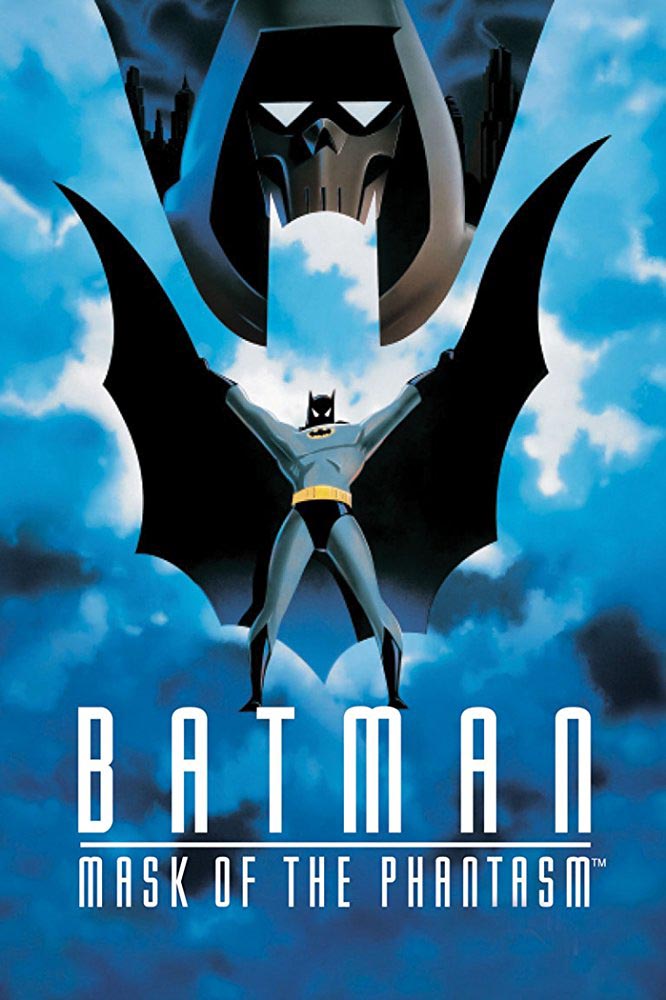I have often had the argument with myself, and with others, about what should be expected from purported film “genres.” I say purported because two of the most problematic “genres” for me are the musical and the animated film. Because, unlike, for example, comedy as a genre that necessitates certain strictures in the film (i.e. humour as a propellant of the plot), musicals and animation emerge more as styles than actual elements in a film’s story. Visually (or aurally) similarities exist but any number of stories could be told through music or animation. And, as much as strides have been made in developing animation from this narrow perspective, audiences still have a limited concept of what an animated film should be.
When “Batman: Mask of the Phantasm” premiered in 1993, I suspect that the expectations of the animation “genre” was one of the bugbears preventing it from achieving commercial success. There were mitigating circumstances, of course — poor marketing, a rushed pre-release ad campaign, and competition from more conventionally-themed animated films—but ultimately I wonder if the strident lack of potent appeal to the children is what prevented the film from enduring as successfully as it should have.

If that preamble sounds generally pedestrian, and it well might, it’s important to remember that as far as superhero themed films go, the most basic of narrative elements are often familiar: a mysterious antagonist must be found, the hero’s goodness is called into question, self-doubt pervades and a woman is caught up in the shenanigans. What makes “Batman: Mask of the Phantasm” notable as a significant film in the canon of Batman films is, well, inter alia, the meticulousness with which the tale is presented.
Often, there is a, sometimes unnecessary, demand for filmmakers to display a perceptible streak of levity in their films. This demand is doubled for anything from the comic book or superhero genre and then double times that if the work happens to be animated. I suspect that, historically, “Batman: Mask of the Phantasm” might have been something of an odd duck for audience members presented with a meticulously grim film intent on the examination of myriad serious issues. Remember, temporally, this was on the backs of the hilarious world crafted in Tim Burton’s Batman films. One of the most effective things that the film does – something which too many films are not able to do as adeptly – is incorporate the flashback technique without it becoming extraneous or frustrating. This is particularly admirable considering that about half of the film is told in flashback.
For “Batman: Mask of the Phantasm” is an origin story, though it, curiously, does not use the origin as the main hook of the story and instead presents it as the secondary element in an already very concise film. This achieves two significant things. For one, it ensures that the movie does not exist – at least not obtrusively – as a “prologue.” What we have here is a film that’s more than (just) a “how Batman became Batman” exercise. One of the critical dangers of presenting origin stories is eliciting the audience’s interest in the superhero before anything superlative or heroic has happened. The second and more important thing the economically deployed flashbacks achieve is propelling a precise symbiotic relationship with the main thrust of the film – the revelation of that deadly Phantasm. The way the flashbacks allow for a smooth integration of Batman’s origin with the film’s main “antagonist” reveals the tight structure of the film, where every action serves towards making that final revelation more effective.
Alan Burnett’s script manages to make a complete whole of Bruce Wayne’s decision to become Batman, his ill-fated romance (and said love-interest’s family drama), the trials of living for your parents whilst all the while playing with familiar relationships of the Batman mythos, such as those of Bruce and Alfred and Batman and The Joker. Shakespeare said brevity is the soul of wit, which points to the goodness that can be found in compression. It’s not so much that I praise Eric Radomski and Bruce Timm for directing a film with so many nuances and making it so short. Instead, I’m impressed with their ability to examine so many aspects of drama on such a small tableau without it resulting in incomplete chaos.
More than a decade before Christopher Nolan’s Batman trilogy, “Phantasm” succeeds at a gloomy but not claustrophobic assessment of the superhero world that does not lose any of its panache for its seriousness. Most significantly, though, I wonder if animation, which deliberately de-emphasises star turns, is a reason the film works so well. There’s no real inclination to wonder about the star making the roles when you cannot see them.
And, can I just applaud the deft handling of the film’s principal female character, Andrea Beaumont? Love interest she may be, but for a 76-minute film with so much to do Andrea is a beautifully constructed and complex character. I hate that almost 25 years after its release, this fact is still something that needs to be so resoundingly cheered but it’s still one of the many things to truly appreciate about this film. If I spend so much time talking up the narrative of the film at the expense of its literal animation, it’s not without reason because Mask of Phantasm is not the prettiest animated film of the decade. Of that year, even. Tim Brayton, in his review, speaks more to its animation pitfalls, which are not overwhelming, but visually it is, perhaps, only good and not excellent. Which makes it only too lucky that it lands so well on the story aspect.
This is not to say that the film wraps up every question it asks with a tidy bow. Before the credits roll, I found myself asking: Why couldn’t those two crazy kids work it out? Or better yet, why isn’t vengeance a noble road to take? Or, most significant, isn’t Batman’s ultimate dilemma his own doing? I realise, though, that the questions which I’m left with are not owing to structural or narrative flaws in the film but instead betray the significant moral issues which this animated film provokes. What does one hope to find in the animated “genre?” Slowly, we’re growing towards awareness that it is more a style than a genre and an eclectic number of different stories can be told using the medium–not a single one. The sensitivity and seriousness with which Batman: Mask of the Phantasm espies its heroes makes me think that perhaps it is that same lack of levity which made it unpopular to audiences in 1993. Conversely, it’s that same lack of levity which – I believe – makes it such an intriguing film for adults. For, be it animated or live action, it’s good when a 76-minute piece of art can leave us asking questions about our ethics. With news of two upcoming Batman films, I wonder if anyone will reach the excellence of this animated Caped Crusader. I think not.
Have a comment? Write to Andrew at almasydk@gmail.com

